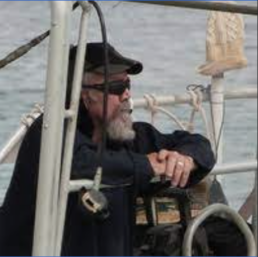These life stories may contain descriptions of childhood trauma and abuse, as well as images, voices and names of people now deceased. If you need help, you can find contact details for some relevant support services on our support page.
Australian academic, historian, and maritime archaeologist, Michael ‘Mack’ McCarthy (b. 1947), was in kinship care, institutions, and foster care as a child.
Michael was taken in by his aunt Frances May when he was two weeks old. Frances was half-sister to his mother, fifteen-year-old Elizabeth. He became Michael Phillip May and was raised as Frances’ son and brother to her daughter.
In 1953, Frances took five-year old Michael to a Father Hudson’s home while her husband was ill. Frances found out Michael had been sent to Australia as a child migrant when she returned to collect him. Frances spent the next five years trying to no avail to regain custody of Michael. Frances was unsuccessful in her attempts in part because she was not the child’s legal guardian. Though he did not seek to learn of his past, when approached by Red Cross in 1993 and advised of her existence, for Frances sake Michael agreed to meet and they had a reunion in an airport after forty years of separation.
In Australia, Michael was initially placed in the St Vincent’s Foundling Home in Subiaco, Perth. The institution, run by the Sisters of Mercy between 1914 and 1971, initially housed children placed privately and wards of the state of Western Australia. Beginning in 1947 the institution also accepted child migrants shipped to Australia from Britain and Malta.
Michael’s second placement was Castledare Orphanage, another institution in a suburb of Perth. It was run by the Christian Brothers between 1934 and 1983.
There like many other child migrants he was set on the path that inexorably led first to Clontarf on the river, further east, and then far inland to the farm schools of Bindoon and Tardun (the Catholic clone of the Fairbridge Farm Scheme (McCarthy, 133)
Next, Michael was placed with Tom and Irene Gollop, who were “generous hosts to many orphan boys from Clontarf, Bindoon and Tardun” (McCarthy). The couple fostered Michael on a long-term basis so their son Christopher (who had special needs) could have a brother. In the process of becoming long-term carers for Michael they learned that his surname was McCarthy.
The Gollops were well-educated, multilingual migrants from England and hosted many refugees from Hungary and Czechoslovakia and elsewhere. They welcomed Michael into their home made up of “avid readers, lovers of opera, books and classical music” (McCarthy). The Gollops nurtured Michael and exposed him to the arts and multiple languages.
Michael began exploring shipwrecks while snorkelling and scuba diving as a young man in Fremantle, Western Australia. After working as a sports teacher in regional and remote communities in Western Australia for ten years, Michael left the teaching profession to pursue maritime archaeology.
Michael went on to have a highly distinguished career as a curator at the Maritime Museum of Western Australia, an Adjunct at Texas A&M University, and Adjunct Professor, at the University of Notre Dame Archaeology.
When I joined the museum, I thought it’ll be okay for a couple of years. I never thought it would continue for so long and never did I think there would be such a growth of knowledge as there has been in the last few years (ABC Local)
One of Michael’s books, Xantho and the Broadhursts (2017) describes his role in the recovery, restoration and conservation of a nineteenth-century steamship and his study of the vessel’s protagonists, the once-obscure Broadhurst family of entrepreneurs, teachers, and feminists. He has been involved in the excavation and study of a number of shipwrecks and curated many exhibitions and is recognised as an essential force in having the ship found and in seeing the mysteries surrounding the loss of HMAS Sydney II and its entire crew resolved. According to Michael, the theme of dispossession and eventual redemption links almost all of his disparate research interests and believes this may be subconsciously linked to his own experience.
Both history and maritime archaeology lend themselves to the study of the dispossessed and forgotten, a natural interest, arguably of any child migrant (McCarthy, p. 138).
References:
“Castledare (1934 – 1983).” Find & Connect, 2021. https://www.findandconnect.gov.au/guide/wa/WE00048
Gray, H. Review of Xantho and the Broadhursts, by M. McCarthy. The Great Circle, vol 40(1): 114–116. https://www.jstor.org/stable/26783786
https://www.linkedin.com/in/michael-mack-mike-mccarthy-2947a828/
McCarthy, Michael. Fremantle: Reflections of a Child Migrant. Studies in Western Australian History, vol.31 (2016): 125-140.
McDowell, Clancy. “The shipwreck coast still revealing its secrets after 300 years.” ABC Local, 4 September 2014. https://www.abc.net.au/local/photos/2014/09/04/4080865.htm
“St Vincent’s Foundling Home (1914 – 1971.” Find & Connect, 2021. https://www.findandconnect.gov.au/guide/wa/WE00196
Image available here.
